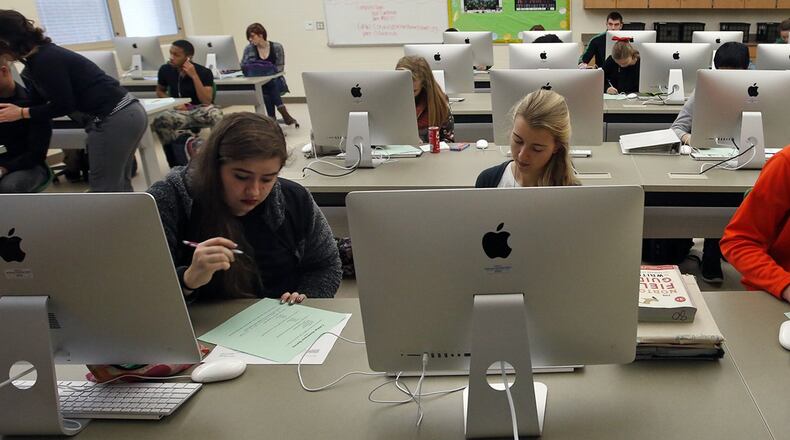But the U.S. Department of Education said one way or another, the tests should go on, with the caveat that there should be no penalties or enforcement for poor test performance or participation levels.
In Ohio, Chris Woolard, ODE’s senior executive director for performance and impact, said the state is still waiting for some details, but he walked through the obstacles to all three new federal options.
“Some of the things they talk about are not feasible or not likely,” Woolard said. “There are logistical and practical challenges to all of those. We’ve tried to do our due diligence to understand how this could play out.”
Woolard said Ohio is “way beyond” the point of developing new, shorter tests, because it takes months to do so in all subjects and grade levels, based on state learning standards, and to set the “cut scores” for each. The state testing window opens in less than four weeks (March 22), and Woolard said paper versions are already being mailed to the districts that are not testing online.
Woolard said the idea of doing state tests remotely is “not ready for prime time,” adding that no large states are trying it beyond small pilot projects. He cited equity concerns given varying quality of internet speed in homes, privacy concerns tied to computer cameras being on, and a need to train test proctors on what it even means to proctor remotely.
As far as pushing the tests back, ODE has already tacked an extra week onto the testing window, meaning schools have until April 30 to give English tests and until May 14 for math, science and social studies. Woolard said pushing tests back any further would start to hit some schools’ summer break.
“We feel like we’ve extended it as much as we can from a practical standpoint to still get it done this school year and get data back in a somewhat timely manner,” Woolard said. “The federal letter said you could even push these into next year. My sense is a (at that point) most districts will want to be moving on and thinking about next year.”
State legislature action?
It’s still possible the state legislature could pass a bill requiring schools to make some form of testing change, but that would have to happen extremely fast given the March 22 testing start date.
The legislature already passed several testing-related provisions late last fall.
House Bill 409 means a school cannot face mandatory restructuring or be taken over by an Academic Distress Commission based on spring 2021 scores. Charter schools cannot face potential closure or sponsor sanctions due to poor scores, and public schools cannot become newly subject to private-school vouchers.
House Bill 404 prohibits schools from using student academic growth data from spring 2021 tests against teachers or principals in their performance evaluations. Third-graders cannot be held back a grade solely for failing to achieve the “promotion score” on the state’s third-grade reading test.
And the 2020-21 state report card to be released in September will not include its usual ratings or overall grades. Woolard said the state is still communicating with the U.S. Department of Education about what specific data will be published on those report cards.
Woolard said one state-test-related consequence does remain in place. In spring 2020, when state tests were canceled, high school students were allowed to use their classroom grade in a course to replace a state test score for graduation purposes. A bill was introduced months ago to make the same provision for this school year, but it did not pass.
To test or not to test?
Most of Ohio’s public school students take state reading and math tests each spring from third to eighth grade, science tests in fifth and eighth grade, and six or seven end-of-course exams at various times across their high school years. Of those 20-21 tests, 17 are federally mandated.
State tests were canceled in spring 2020, as the coronavirus pandemic took hold and school buildings were shuttered.
The nation’s two large teachers unions, which have long opposed standardized testing as unreliable, issued statements expressing frustration that the U.S. Department of Education didn’t offer outright waivers to cancel the tests. The Ohio School Boards Association said Tuesday it would not comment on the federal testing guidance, saying it has not had enough time to review the document.
Teachers unions and some other education groups have said schools’ internal diagnostic tests are better than state tests at quickly and efficiently determining where students stand and what help they need.
But others say broader testing this spring also would be valuable, to avoid a two-year data gap, to compare the results of students who learned via different models, and to track which students might have fallen further behind during the pandemic.
Woolard pointed to Ohio’s fall 2020 third-grade reading test, which showed not only that proficiency rates were 8 percentage points lower than in 2019, but that Black students and fully remote students were further behind, as their proficiency rates decreased by 12 points.
“This (testing) is going to set an important baseline for the state moving forward into future years,” Woolard said. “We’re sort of going into recovery mode over the next couple years, or however long it takes us to recover. It’s really important to have baseline information to know where we’re at.”
About the Author

